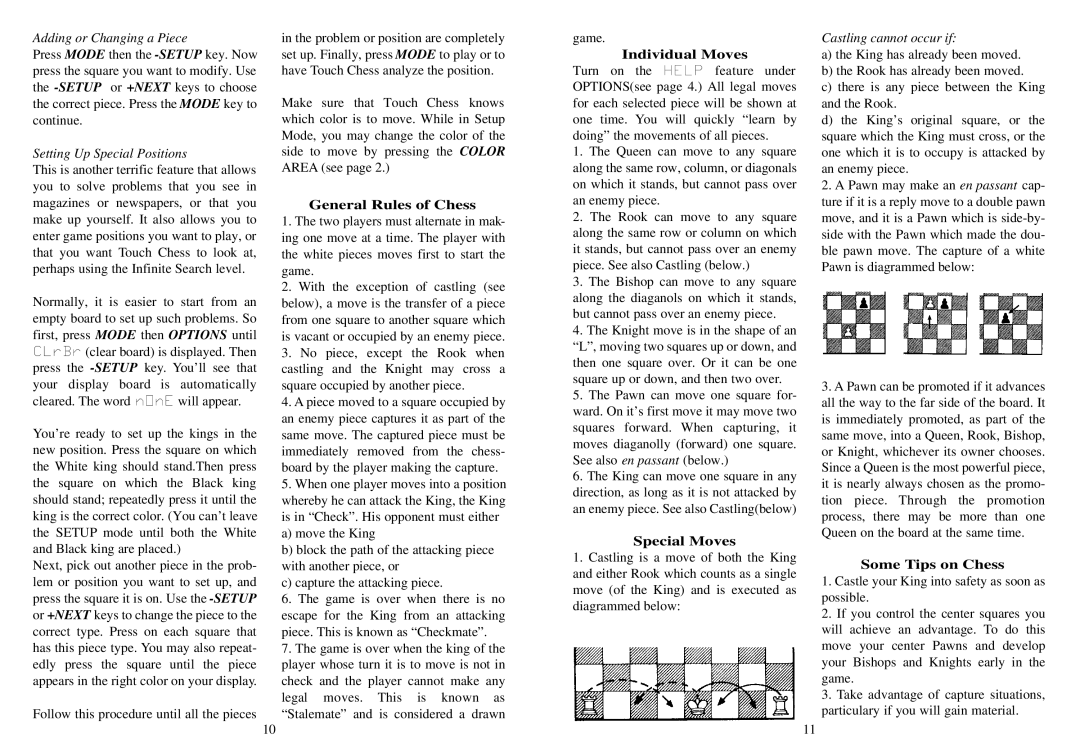
Adding or Changing a Piece
Press MODE then the
Setting Up Special Positions
This is another terrific feature that allows you to solve problems that you see in magazines or newspapers, or that you make up yourself. It also allows you to enter game positions you want to play, or that you want Touch Chess to look at, perhaps using the Infinite Search level.
Normally, it is easier to start from an empty board to set up such problems. So first, press MODE then OPTIONS until ![]()
![]()
![]()
![]()
![]() (clear board) is displayed. Then press the
(clear board) is displayed. Then press the
cleared. The word ![]()
![]()
![]()
![]() will appear.
will appear.
You’re ready to set up the kings in the new position. Press the square on which the White king should stand.Then press the square on which the Black king should stand; repeatedly press it until the king is the correct color. (You can’t leave the SETUP mode until both the White and Black king are placed.)
Next, pick out another piece in the prob- lem or position you want to set up, and press the square it is on. Use the
Follow this procedure until all the pieces
10
in the problem or position are completely set up. Finally, press MODE to play or to have Touch Chess analyze the position.
Make sure that Touch Chess knows which color is to move. While in Setup Mode, you may change the color of the side to move by pressing the COLOR AREA (see page 2.)
General Rules of Chess
1.The two players must alternate in mak- ing one move at a time. The player with the white pieces moves first to start the game.
2.With the exception of castling (see below), a move is the transfer of a piece from one square to another square which is vacant or occupied by an enemy piece.
3.No piece, except the Rook when castling and the Knight may cross a square occupied by another piece.
4.A piece moved to a square occupied by an enemy piece captures it as part of the same move. The captured piece must be immediately removed from the chess- board by the player making the capture.
5.When one player moves into a position whereby he can attack the King, the King is in “Check”. His opponent must either a) move the King
b) block the path of the attacking piece with another piece, or
c) capture the attacking piece.
6.The game is over when there is no escape for the King from an attacking piece. This is known as “Checkmate”.
7.The game is over when the king of the player whose turn it is to move is not in check and the player cannot make any legal moves. This is known as “Stalemate” and is considered a drawn
game.
Individual Moves
Turn on the ![]()
![]()
![]()
![]() feature under OPTIONS(see page 4.) All legal moves for each selected piece will be shown at one time. You will quickly “learn by doing” the movements of all pieces.
feature under OPTIONS(see page 4.) All legal moves for each selected piece will be shown at one time. You will quickly “learn by doing” the movements of all pieces.
1.The Queen can move to any square along the same row, column, or diagonals on which it stands, but cannot pass over an enemy piece.
2.The Rook can move to any square along the same row or column on which it stands, but cannot pass over an enemy piece. See also Castling (below.)
3.The Bishop can move to any square along the diaganols on which it stands, but cannot pass over an enemy piece.
4.The Knight move is in the shape of an “L”, moving two squares up or down, and then one square over. Or it can be one square up or down, and then two over.
5.The Pawn can move one square for- ward. On it’s first move it may move two squares forward. When capturing, it moves diaganolly (forward) one square. See also en passant (below.)
6.The King can move one square in any direction, as long as it is not attacked by an enemy piece. See also Castling(below)
Special Moves
1.Castling is a move of both the King and either Rook which counts as a single move (of the King) and is executed as diagrammed below:
Castling cannot occur if:
a)the King has already been moved.
b)the Rook has already been moved.
c)there is any piece between the King and the Rook.
d)the King’s original square, or the square which the King must cross, or the one which it is to occupy is attacked by an enemy piece.
2. A Pawn may make an en passant cap- ture if it is a reply move to a double pawn move, and it is a Pawn which is
3.A Pawn can be promoted if it advances all the way to the far side of the board. It is immediately promoted, as part of the same move, into a Queen, Rook, Bishop, or Knight, whichever its owner chooses. Since a Queen is the most powerful piece, it is nearly always chosen as the promo- tion piece. Through the promotion process, there may be more than one Queen on the board at the same time.
Some Tips on Chess
1.Castle your King into safety as soon as possible.
2.If you control the center squares you will achieve an advantage. To do this move your center Pawns and develop your Bishops and Knights early in the game.
3.Take advantage of capture situations, particulary if you will gain material.
11
